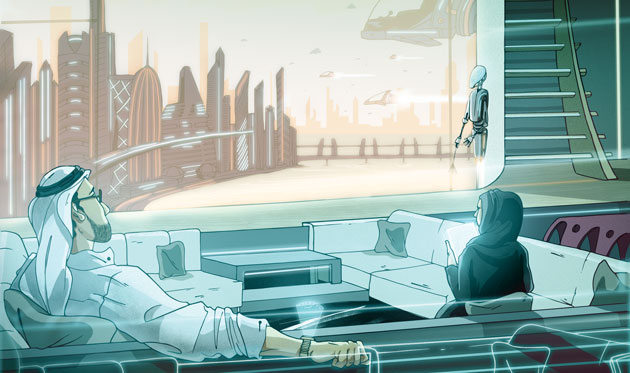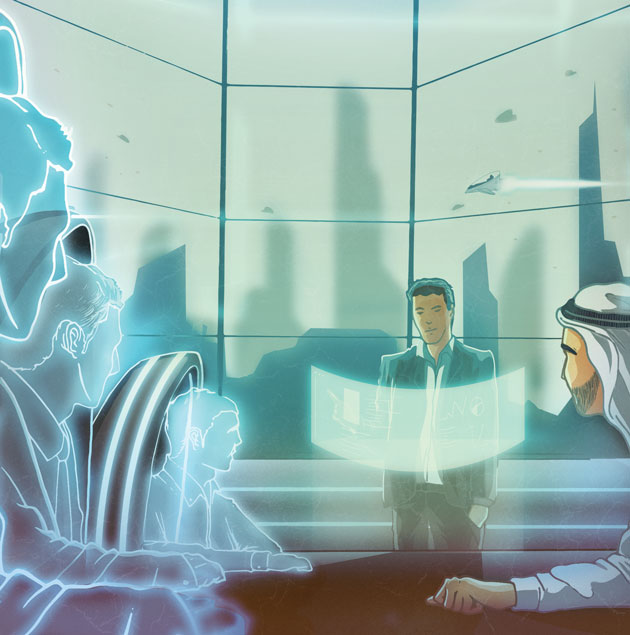What will Qatar look like in 2050?
What will Qatar look like in the middle of this century? Barry Mansfield presents a semi-fictional vision of likely changes in cultural and economic life brought about by a ‘rise of the machines’ - and how Qataris may blend the traditional and high technology in a way that is agreeable to them.
 Envisaging Doha’s 21st Century zenith. Illustrations by Rishab Soni
Envisaging Doha’s 21st Century zenith. Illustrations by Rishab SoniThe year is 2050, 28 years on from Qatar’s successful hosting of the 2022 World Cup and 20 years after the culmination of the 2030 National Vision of HH the Father Emir Sheikh Hamad bin Khalifa Al Thani, guided to fruition by current Emir HH Sheikh Tamim bin Hamad Al Thani.
Welcome to Doha at its 21st century ‘knowledge economy’ zenith. Self-lighting trees from California’s Glowing Plant Lab illuminate the numerous clean, wide promenades. Long-time students head home from evening class in automated taxi pods, which can be called by mobile phone, or via tiny sensors built into their eyewear, clothes, watch, ring or bracelet. Full immersion video gaming is a hit pastime.
Henry Ford’s vision of the Sky Car is now here and the popular Aeromobil models can often be spotted over the capital, but they are still mainly the preserve of business leaders and dignitaries. Most Qataris simply jump onboard the Hyperloop, an elevated, reduced-pressure tube where pressurised capsules whisk passengers across Doha in seconds and throughout the Gulf Cooperation Council, which now includes the United Arab Republic of Yemen, at speeds of more than 1000 kilometres per hour. Many commuters travel to finance jobs in Dubai and Karachi or to oversee manufacturing in Iraq and Yemen. Reclaimed desert around the capital is a lush green tapestry of farmland and tropical forest, and dotted with vast solar powered ‘hydroponic’ hubs where part-time Qatari workers and robots cultivate fruit and vegetables for home and overseas markets.
In a world where technology has replaced people in many roles, these are now popular hobbyist jobs for students and older Qataris. In fact, the emirate has peaked, resulting in the departure of many foreign workers; the population has dropped to around 2.1 million from a high of 4.6 million in 2020. The goal of food security was achieved in 2040 and Qatar is now more than 85 percent self-sufficient in food production and self sufficient in water thanks to an affordable osmosis from salt water technique perfected by a young Qatari student at Texas A&M University in 2028 and now widely used around the world.
Real-time language translating machines, developed in Qatar, are incorporated into devices such as smart eyewear.
Despite all the high-tech enhancements, it is still easy to walk and cycle around Doha. There is a huge green belt to prevent urban sprawl. Living standards are extremely high; these days it is common, thanks to advanced medicine, to live a healthy life well into your 90s and beyond. Every target in the Qatar National Master Plan has been surpassed.
Intellectual capital
Fulfilling one of the basic tenets of Qatar’s knowledge economy ambitions, the country has the highest standard of education in the world, with more than 40 of the world’s best universities – Qatari, Arab, Western and Asian – hosting campuses at the sprawling complex of Education City, itself now regarded as the world capital of education. Most learning here is accomplished through intelligent, adaptive courseware presented by computer-simulated teachers. In the learning process, human adults fill the counsellor and mentor roles instead of being academic instructors, who are often not physically present, and help students remotely.
Though English and Arabic are the most widely spoken languages, real-time language translating machines, developed in Qatar, are incorporated into devices such as smart eyewear, are routinely used in conversations. Effective language technologies (natural language processing, speech recognition and speech synthesis) are in common use. According to Android vice president Hugo Barra, these were ‘near-perfect’ for some languages in 2013. However, it took much longer for Google, Microsoft and Japan’s NTT Docomo to deliver the service in a non-intrusive and fashionably acceptable way - soft contact lenses are sleek, and evolved from Google Glass. Innovega led the early work here, eventually collaborating with a number of Qatari start-ups.
An automotive revolution
Commuting is transformed as self-driving vehicles eliminate accidents and free up time for leisure and work. Audi, BMW, GM and Google tested them first. The search engine giant wanted them on the roads by 2020 but safety experts warned as early as 2012 that the failure of governments to agree on objective performance standards would delay their arrival significantly. The Institute of Electrical and Electronics Engineers predicted that autonomous cars would account for up to 75 percent of vehicles on the road by the year 2040. In Qatar in 2050, it is closer to 90 percent.

Alongside the high–speed Hyperloop train perfected by Elon Musk in 2026, holographic video conferencing reduces the need for frequent business travel. Cisco Telepresence was a frontrunner in this field. Job posts by Microsoft Research in mid-2013 suggested that it was then “developing the hardware and software necessary to have a realistic physical ‘body-double’ or proxy in a remote meeting… that gives the remote worker… the ability to look around the room, turn to a colleague and have a side conversation.”
By 2050, The Human Media Lab at Queen’s University in Kingston, Ontario in Canada has developed a life-sized hologram-like telepod that uses Microsoft’s Kinect System and a cylindrical display for live, 3D in-person communication, which has become the product of choice around the world.
An automotive revolution has also taken place. The limited amount of oil and gas remaining are still utilised as energy source, but will only be used in niche industries where its unique combustible elements are still in demand. In 2013, Colorado’s DaVinci Institute predicted that friction-free technologies and material science advances would reduce the typical passenger vehicle to around 90 kilograms in weight, and the price to under USD5000 (QAR18,200) in the said year’s currency. By 2050, there has been a near-complete transition from electric to binary power (where two otherwise harmless beams of energy will intersect at some point in space creating a source of energy) as the main source of vehicular power. From 2030, much of this technology was developed by researchers in Qatar and created by joint ventures with international firms.
A smart grid links all household appliances directly to energy distribution systems, enabling real-time pricing based on supply and demand. However, in 2013 the European Photovoltaic Industry Association suggested that by 2030, the cost of solar photovoltaics in ‘sun belt’ countries would have dropped to just QAR0.2-0.39 per kilo watt hours - clean electricity is already very affordable in 2050. The Smart Grid concept has been reevaluated since the days of IBM’s first contract in Qatar, because air pollution and congestion are no longer a problem, and most devices are now highly energy efficient.
Nanotech-based manufacturing is widely used, altering the economy as products (from micro-batteries to phones and medical implants) can be produced for a fraction of their traditional manufacture costs. The true cost of any product is now the amount it takes to download the design schematics. Partly thanks to the trailblazing work of Harvard University in 3D nanoprinting back in the mid-2010s, Qatar, like many developed countries, can now easily manufacture many items for its own domestic market.
Quality of life
Money has deflated in value, meaning all sorts of goods and services have become cheaper. As economics writer Paul Mason put it decades ago, “Information goods will be more prevalent than real goods, eroding the price mechanism as a means of distribution.” A number of international digital (‘crypto’) currencies, including the ‘e-riyal’, thanks to Qatar’s dominance in global IT for the past few decades, have taken the place of the primitive bitcoin, offering superior security and anonymity, quick transfers and very low transaction fees. Governments and corporate cartels are unable to manipulate these new currencies the way they used to before the great global economic crash of 2017.
Qatar has the highest standard of education in the world, with more than 40 of the world’s best universities in Education City.
There is widespread use of ultrasonic advertising, where two beams intersect to deliver a localised sound message that a person can hear, and can also control by selecting only to hear messages or brands from certain advertisers. Nokia was an early mover in holographic advertising. Available for a long time, it uses a combination of Mylar screens, super high-definition overhead projectors and reflective surfaces, but is now much more life-like, with clearer images. Holograms have gone portable – via personal, iPad-sized display pieces, including the Chinese-owned Facebook-Apple Corporation’s iHolo mobile device.
Food in Qatar is commonly ‘assembled’ by nanomachines. This food is externally indistinguishable from ‘natural’ food. It can be made more wholesome as production can be controlled at the molecular level, phasing out the crude genetic modification. This technology decouples food production from the availability of natural resources. It saves a huge cost, enabling restaurants to spend more on high quality, tasty ingredients and gourmet cooking techniques. The assembly method also improves hygiene, as well as reduces preparation space and ultimately real estate rental costs. With the national obesity and diabetes epidemics of the 2010s a distant memory, fast–food chains are a thing of the past.
Nevertheless, in certain areas traditional restaurants thrive, and worldwide Qatar is regarded as one of top destinations in the world for cultural, technological tourism, recreational choice, for work and the general happiness of its inhabitants. The Qatari capital has in fact made the 10 of Mercer’s Quality of Living Survey since 2029.
Home to Qatar Spaceways, Doha is also one of a select few world spaceports, with weekly rocket flights departing to human colonies on the Moon and Mars (many of which use the same hydroponic food growing techniques perfected in Qatar) making it a truly intergalactic capital city.
Like this story? Share it.





